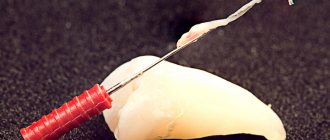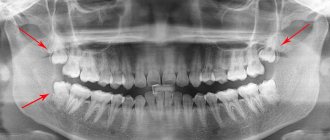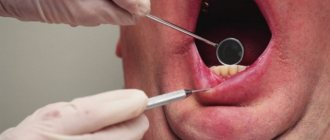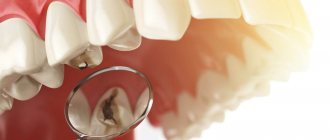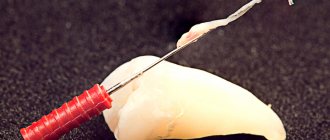When are teeth filled?
As a rule, a filling is placed after depulpation during diseases such as:
- caries;
- periodontitis;
- pulpitis.
The choice of filling installation method will directly depend on the specific case and is determined by the treating dentist. A professional specialist never installs a filling without first taking care to relieve inflammation after treatment. The filling is placed on a healthy tooth - if the treatment was not good enough, the disease will soon make itself felt again.
Installing a filling on a tooth: indications
It is recommended to put a filling in dentistry mainly for caries. This is a pathological process that consists of the slow, gradual destruction of tooth tissue under the influence of bacteria contained in soft plaque. As a result of their vital activity, these bacteria produce acids that destroy calcium in tooth enamel. The enamel becomes fragile and is destroyed, forming carious cavities, which, without proper treatment, gradually increase more and more.
By installing a filling on a tooth, you can restore a crown that has been destroyed by caries by about a third. If the tooth tissues are more damaged, then other methods of their restoration are used.
However, caries is not the only reason to get a filling in dentistry. Filling can also correct:
- cracks and chips of enamel;
- traumatic injuries;
- erased enamel (with bruxism).
Preparing for dental fillings
Preparation is carried out in several main stages, the purpose of which is to minimize the risk of foreign substances entering the tooth and reduce the patient’s pain from the procedure. The dentist is required to check each tooth canal for the presence of foreign contaminants, as well as the absence of inflammation or other disease that could cause it.
When preparing, the doctor adheres to a strict sequence of actions:
- Elimination of damaged and dead tissue.
- Depulpation.
- Acquaintance with the anatomy of dental canals, measuring their main parameters: length, width.
- Pre-treatment of the canals as preparation: this will expand them and be ready for filling.
- Sealing the canals with a special hermetic material.
All of the above actions are taken by the dentist exclusively while the patient is under local anesthesia.
Dental microscope for filling
This device is an irreplaceable thing in certain cases when:
|
A microscope and other optics allow the dentist to take a closer look at the problem in order to best solve it: often incorrect actions of your previous attending physician can negatively affect new procedures if you are not careful enough to notice the problem in time.
Quite often, upon close examination, it turns out that mistakes were made in installing the seal or its depressurization was detected - these are sure signs of incorrect treatment.
Symptoms for which people consult an orthopedic dentist
Consultation with a specialist is necessary if the following symptoms are present:
- absence of any number of teeth in a row (as a result of planned removal, loss, after injury, etc.);
- partial or almost complete destruction of the enamel and walls of the tooth;
- diagnosed diseases of the gums or jaw bones;
- increased (and in some cases painful) tooth sensitivity;
- various types of TMJ disease (temporomandibular joint);
- cosmetic defects (in particular, irregular shape, pigmentation and other disorders that spoil the aesthetics of the smile).
A dental therapist or other highly specialized specialist can diagnose problems that should be addressed specifically by an orthopedic dentist after an initial examination and consultation.
You might be interested in:
Pulpitis
Dental restoration
Treatment of caries
Dental treatment
Materials for filling
After examining the dental canals and carrying out all the necessary treatment procedures, the dentist will have to choose the right material for the future filling. They differ in their elasticity, purpose and properties. Some fillings can disinfect the area nearby, thereby preventing a new disease, while others can only correct the tooth, relieving the patient of discomfort and the entry of food particles into the root canal.
Among the most popular mixtures:
- Gutta-percha
- fills the canals well and is quite elastic, but has shrinkage; - AH-plus
- has an antimicrobial effect, wear-resistant; - Metapex
- has an antibacterial effect; - Akrosil
- often used with gutta-percha; - Forfenan
- is not used for front teeth, as it can stain them, but has a good antibacterial effect.
Today, dentists rarely use only one mixture when installing a filling: this approach is considered ineffective due to the individual characteristics of each solution.
Rules for the treatment of baby teeth
- Anesthesia takes place in 2 stages. This is necessary so that the baby does not feel anything and is not afraid. First, a gel or spray and lidocaine are applied to the gums. Only then is the injection given. For this, the finest needles are used.
- Tissues affected by caries are carefully removed using a special hand tool.
- A safe concentration of anesthetic in the drug is maintained. For Lidocaine it is 2%, for Articaine – 4%. The amount of the drug is selected depending on the weight of the child. Apply from ½ to 1/6 of the standard adult dose. Anesthetics containing adrenaline should not be used for children under 4 years of age.
- Treatment of caries is carried out in sessions. Each should last no more than 30 minutes. Otherwise, the baby will get tired and become capricious.
- Filling materials are used that can be applied in one go. They contain fluoride and other minerals to strengthen teeth.
“Permanent 6th teeth erupt in children aged 5-6 years and, as a rule, are affected by caries first. Teach children how to use toothbrushes and toothpastes correctly, which will prevent plaque from accumulating in deep fissures.”
Rita Martikovna Meliksetyan, Dentist therapist, orthodontist, pediatric dentist, 19 years of work experience
How can you tell if the filling is installed properly?
To check the installed filling, an additional photograph must be taken, which should show how well the dentist’s work was done. The filling material is highlighted in white, so even a person who does not understand dentistry can understand the picture. Each dental canal should be evenly filled with mixture from start to finish, and there should be no blurring, obvious holes or voids, or foreign objects, which could be a broken instrument.
Carefully check the quality of the work performed, because this is the key to the health of your teeth!
Techniques used by an orthopedic dentist
Already knowing what an orthopedic dentist treats, it’s time to understand what techniques he uses to achieve his goals. Today there are three of them:
- Microprosthetics
. Suitable for cases where the patient has only cosmetic defects and there is a high degree of preservation of the tooth (only the upper part is damaged). To implement microprosthetics, the following are used:- Veneers
. Designed to adjust the appearance of the tooth in color and shape. Ideally mask enamel defects and slight curvature. They are thin plates that are attached to the front of the teeth using special glue. The average service life is about 10 years. - Lumineers
. The design and method of use/installation are similar to veneers, but thinner. Their installation does not require preliminary grinding of all tooth enamel. - Tabs
. Unlike veneers and lumineers, they are used not on the front teeth, but on the chewing teeth. They are visually similar to fillings, but are made not from composite materials, but from ceramics. - Removable prosthetics
. Orthopedic structures for this type of prosthetics are a nylon or plastic base with securely attached artificial teeth. There are two types of such prostheses:- full
(over the entire jaw with complete edentia); - partial
(similar to “bridges”, but they can be removed from the mouth independently). - Fixed prosthetics (permanent)
. This type of prosthetics involves the use of:- Coronok
. Acts as an alternative to filling and artistic restoration. Used in cases of significant tooth decay. They are cap-shaped structures that completely or partially cover the tooth being prosthetized. They are made of metal, metal-ceramics, plastic and a combination of metal and plastic. - Bridge prostheses
. They are used in cases where several teeth in a row are missing in a row. They are structures consisting of two supporting crowns (placed on supporting units) and a “bridge” with artificial teeth located between them. - Implants.
A completely artificial structure, part of which is implanted into the bone tissue of the jaw (over time, complete engraftment/fusion occurs). They consist of artificial roots on which an artificial tooth is placed (screwed).
Such prostheses are attached using clasps (semicircular locks), suction cups, or glue (depending on the type of prosthesis).
Now you know what an orthopedic dentist treats and what modern techniques he uses for this. Don’t aggravate existing dental problems - plan to schedule a consultation with a prosthetist soon to learn more about how exactly your individual issues can be solved.
Consequences of poor quality filling
A poorly filled tooth can not only cause an acute reaction of the body, but also a new infection, often with subsequent complications.
What does a bad filling mean?
- inflammation;
- flux and fistula;
- loss of filling;
- change in tooth color;
- allergy to the filling material;
- cyst and granuloma;
- exit of material beyond the root tip.
If you feel acute discomfort after installing a filling, be sure to contact your dentist! Timely consultation with a professional can save you from unpleasant diseases, which are accompanied not only by continuous pain, but also by high costs for their treatment.
Who is a periodontist?
A periodontist is a highly qualified dentist with a higher medical education who specializes in the correction and prevention of pathologies of soft tissues that fix segments in the jaw bone. The concept of “periodontium” includes:
- mucous membranes that line the surface of the mouth;
- soft gum tissue surrounding the segments;
- periodontium is a thin layer of connective tissue between the alveolar process and the cementum of the tooth;
- dental cement - mineral tissue surrounding the root;
- alveolar process - a dental bed penetrated by capillaries and nerve endings.
